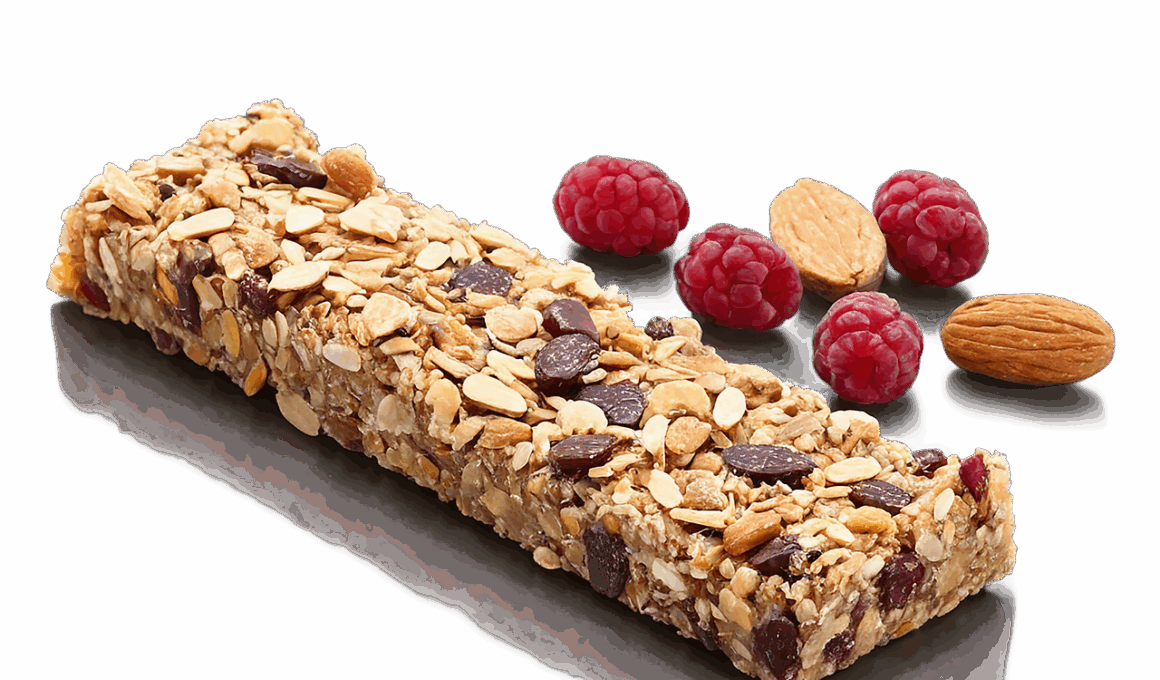Energy Bar Timing Strategies for Different Types of Athletic Events
Energy bars serve as essential fuel for athletes, providing crucial nutrients and energy necessary for peak performance. However, the timing of consumption can be just as important as the nutritional content. Athletes must consider the duration and intensity of their events when deciding when to eat these energy bars. For short, intense workouts, consuming an energy bar roughly 30 minutes prior can help maximize energy levels. For longer events, strategically timing your bar intake during the activity can help maintain energy without causing gastrointestinal distress. It’s important to test the timing and the products during training sessions to find what works best for individual needs. Balancing carbohydrates, proteins, and fats, energy bars can significantly contribute to enhancing endurance. Additionally, choosing bars with a lower fiber content may help athletes avoid digestive discomfort during races. Overall, effective energy bar timing can lead to improved performance, allowing athletes to push their limits while minimizing fatigue. To make the right choices, athletes should also listen to their bodies and adjust according to their personal experiences and preferences. Remember, nutrition is individual; what works for one may not work for another.
Timing Recommendations for Sprint Events
Sprint events require athletes to harness explosive energy in a short amount of time, making nutrition extremely critical. For sprinters, timing energy bar consumption just before the race is often recommended to maximize immediate energy supply. Eating a carbohydrate-rich energy bar about 30 minutes prior to sprinting can help ensure the body has readily available glucose for quick bursts of speed. Additionally, it is advisable to opt for bars that contain moderate protein to support muscle function without causing heaviness. Experimentation during training with various flavors and textures can help sprinters find the most agreeable options, preventing any muscle fatigue before races. It’s crucial to look for products that are easily digestible to avoid gastrointestinal issues. While shorter events may not require mid-race nutrition, consuming an energy bar immediately following a sprint can expedite recovery by replenishing glycogen stores and supporting muscle repair. The right bar can also serve as a mental treat, aiding in post-race recovery satisfaction. Thus, timing and choice of energy bar are pivotal for sprint performance and recovery, leading to better competitive outcomes.
Conversely, endurance athletes face different nutritional challenges due to the longer duration of their events. For marathons and long-distance cycling, strategizing energy bar intake becomes key. These athletes must focus on maintaining consistent energy levels throughout their activities. Energy bars should be consumed at regular intervals during the competition, typically every 45-60 minutes. This allows for continuous replenishment of depleted glycogen levels. Choosing high-calorie bars can be beneficial, offering both sustained energy and fast-digesting carbohydrates to prevent mid-event slumps. Options with added electrolytes or hydration components can also enhance performance, particularly in hot conditions. Many bars on the market cater specifically to endurance needs, delivering not only the energy required but also important vitamins and minerals. Consider testing these bars during training runs or rides to determine how your body responds. Pay attention to preferences regarding taste and texture to establish a reliable energy strategy. Last but not least, hydration should accompany energy bar intake, as optimal performance relies on both fuel and fluids. Awareness of how your body reacts to different timings can lead to improved race performances.
Impact on Recovery After Events
Nutritional strategies do not stop with the end of athletic events; recovery is equally vital. Post-exercise, an energy bar can provide athletes with the necessary nutrients to kick start the recovery process effectively. Consuming an energy bar rich in carbohydrates and protein within 30 minutes after exercising is optimal; this helps replenish glycogen stores and repair muscle damage. When contemplating choices, look for bars specifically designed for recovery, often marketed as post-workout solutions. These typically contain added protein and possibly branched-chain amino acids (BCAAs), aiding in muscle recovery. Additionally, following bar consumption, pairing with water is crucial for hydration. Athletes should establish a routine that includes pre-event strategy and immediate post-event nutrition to achieve the best outcomes. Timing and the right nutritional choices directly influence how quickly and effectively athletes return to training. It’s also advisable for athletes to monitor how specific products impact recovery times personally, aiding in adjustments and future choices. Adherence to these principles can provide significant advantages during training regimens or competitive seasons, maintaining peak athletic performance.
One common mistake athletes make is neglecting their nutritional strategies between events or training sessions. Establishing a consistent meal plan that incorporates energy bars at designated times can enhance overall athletic performance. For example, utilizing energy bars as snacks throughout the day can ensure a steady calorie intake, contributing to sustained energy levels. It’s also beneficial to vary bar flavors and brands to avoid palate fatigue, particularly during longer training phases. Many successful athletes incorporate this strategy into their daily diets, making it an essential part of their routines. Consider including different energy bar options post-workout or throughout busy days to ensure your nutrient needs are met. These simple adjustments often yield noticeable performance benefits over time. Moreover, athletes should educate themselves on reading labels, focusing on the ratios of carbohydrates, proteins, and fats to match personal energy requirements. A lack of awareness can lead to suboptimal choices, which could affect performance negatively. Throughout the training period or during competitions, remember that nutrition plays a crucial role in supporting your athletic goals and enhancing physical capabilities.
Choosing the Right Energy Bar
Choosing the right energy bar is crucial for maximizing performance. Not all energy bars are created equally, and each serves different dietary needs and purposes. When selecting a bar, consider factors such as the event type, duration, and personal taste preferences. Ingredients matter as well; prioritize bars that contain whole foods and natural sweeteners. Look for options high in complex carbohydrates, which provide sustained energy without rapid spikes in blood sugar that might lead to crashes. Brands often present various choices, including gluten-free, vegan, or protein-enriched bars, catering to diverse dietary restrictions. Reading reviews and trialing different bars during training can provide insights into what works best for the individual athlete. Some athletes may prefer bars with a chewy texture, while others may gravitate towards crunchier options. Creating a collection of trusted products can aid in determining energy strategies ahead of competitions. Also, always factor in how soon before an event you’re consuming the bar; some people digest faster than others. Therefore, personal experimentation is essential to fine-tune these aspects of athletic nutrition.
In conclusion, energy bar timing strategies significantly impact an athlete’s performance across various events. Incorporating these nutritional tactics can contribute to immediate energy sources, optimizing both performance and recovery. Athletes should keep in mind that these tactics are not universal; it is crucial to personalize them to align with specific needs and preferences. Understanding the timing for consumption, knowing when to eat before and after events, and selecting the right products are vital steps toward peak performance. It’s often about finding the perfect balance between nutrition and athletic goals. Furthermore, making informed decisions based on personal trials during training will lead to better outcomes in competitive settings. Athletes should always remain open to adjustments in their nutritional plans, adapting as they learn from each experience. Engaging in consistent monitoring of performance and recovery metrics will provide valuable insights into what works or needs recalibrating. Ultimately, fueling the body properly boosts energy levels, enhances performance, and aids recovery, forming a strong foundation for athletic success.
Final Thoughts on Energy Bars and Performance
To wrap up, the role of energy bars in an athlete’s nutritional strategy cannot be overstated. Proper timing and selection can significantly influence performance and recovery outcomes. Athletes should constantly evaluate their preferences, examining how various bars align with their training routines and event requirements. Personal experiences will distinguish the bars that provide beneficial support from those that might impede performance. As athletes strive toward their fitness goals, balanced nutrition remains foundational. Prioritize strategies that cater to your specific sport, training intensity, and duration. Experiment with different timings during training sessions before settling on a consistent routine. Learning how to utilize energy bars effectively is an ongoing process, ultimately contributing to enhanced athletic performance. Stay informed about new nutritional products entering the market; innovation within the field can yield exciting new options to include in your regimen. Embrace the journey, enjoy finding the best energy solutions suited for your needs, and refine your strategies continually based on what works best. In this way, athletes can optimize their nutritional practices, leading to positive results during competitions.





